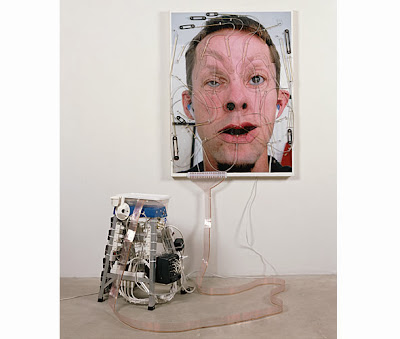1) Post the picture you took in class on your blog; explain briefly the idea behind this picture. What have you noticed that made you take this picture?
I took a picture of an elevator sign, thinking why there are only men? Why there are no women? How about children? Am I too a feminist? :P Also, I wondered where they are going...up in heaven?!or down in hell?!
I also took this picture of an emergency sign, thinking the figure seems implausibly calm
2) Come up with 2 interesting ideas what you would like to do with this image, where you would like to go from here, artistically. Write these ideas down so we can share them in our next session. Create sketches or layouts if you think that would help to introduce your idea/s.
-I was thinking about making a moving image out of these two signs. For example, use the photo of the elevator sign and make it as if the elevator is moving.
-I was thinking about creating an entirely new scene just using the photographs by rearranging the placements of figures in the pictures, adding new figures, etc.
3) Research 2 artists who work with photography as an artistic process. Create a little blog entry with 1-2 select projects each and a short intro that documents your choices photography creatively.
Tim Hawkinson
Born in San Francisco, California, in 1960, Tim Hawkinson is a graduate of San Jose State University. He later earned his MFA at the University of California, Los Angeles, in 1989. Hawkinson is renowned for creating complex sculptural systems through surprisingly simple means.The source of inspiration for many of Hawkinson’s pieces has been the re-imagining of his own body, and what it means to make a self-portrait of this new or fictionalized body. In 2002, the artist created an installation called Emoter as seen in the images below:
 |
| Emoter, 2002 Altered Ink-Jet Print, Monitor, Stepladder & Mechanical Components 4' 1"(H) x 1' 5"(W) x 1' 4"(D) Ace Gallery |
 |
| Emoter, detail, 2002 |
"’Emoter’ uses the expressions of the face that are so cued into reading the face. I took a picture of myself and cut the features up into little pieces, like a puzzle, and rearranged the features. And each time I did it, I created a different emotion, and that’s just something I read into it. Anybody looking at it would read into this, would reinterpret it, as I think we all pretty much interpret the same basic emotions- frowning, smiling- but I was interested in seeing how much inflection and emotion I could get out of the face using random input of signals."
- Tim Hawkinson

Atta Kim
Born on Geoje Island in South Korea in 1956, Atta Kim studied mechanical engineering at Changwon University and earned a Bachelor of Science degree. Kim began experimenting with photography in junior high school, though he never studied it academically. Kim uses photography to create dramatic, large-scale works that reflect his fascination with philosophical questions.
"All things eventually, however, disappear"
-Atta Kim
For the “On-Air Project” (2002 to the present), Kim employs extended exposures, sometimes lasting twenty hours, to create haunting images that suggest the ephemerality of human existence.
 |
| In the "Sex Series" (2003), part of the "On-Air" exhibition, a couple making love was photographed for one hour. |
 |
| In this eight-hour-long-exposure photograph taken from the intersection of Fifth Avenue and 57th Street, the buildings are crisp and life is just a shadow. |
4) Think about photography for a little bit and about its materiality and the process of taking a picture and in which way it lends itself to art-making. Make 3 connections to children. Be thoughtful in your observations.
-instead of creating an image, it's about capturing a part of the world around you
-seeing through lens instead of being in front of a canvas or paper
-framing
-seeing something which others do not necessarily pay attention to and making the others to see it
Children and Photography
-they have keen eyes
-they mirror what they see and experience
-they can be manipulated





In case of fire use stairs: I found that very funny and intriguing to pursue to tell a 10-image story with different scenarios...
ReplyDelete